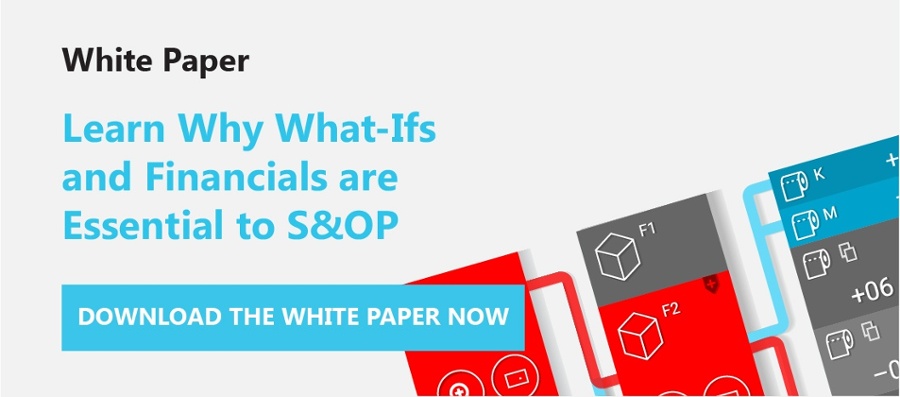While most agree that adding a financial aspect enhances S&OP, there’s often a completely different understanding about its importance. So, let’s dig a bit deeper to understand the difference between S&OP and IBP.
What Is S&OP?
The first problem when trying to develop an understanding of S&OP is that the definitions vary widely. Rather than trying to argue which is right, it’s perhaps best to go back to the beginning and understand the original ideas of the creators of the concept, Oliver Wight and Dick Ling. At that time, they were grappling with production planning models and initially called the process “sales and operational planning,” a term that was subsequently abbreviated to S&OP. Together, they realized that successful production planning needed to consider demand, production capacity and supply, and from this, they developed the five-step S&OP process of:
- Gathering data
- Sales or demand planning
- Production and supply planning
- A review meeting
- S&OP approval at an executive meeting
With a natural emphasis on managing the supply chain, S&OP is usually driven by the Supply Chain manager.
A Definition for IBP
As with S&OP, there are many definitions of integrated business planning (IBP). Perhaps the best is from one of the originators of S&OP, Oliver Wight, who describe it as an extension of the principles of S&OP to include the entire organization to deliver a seamless management process. Note that it’s a broader concept than S&OP and operates at a higher level in the organization. Its purpose is to align all business functions with the organization’s short-, medium-, and long-term goals. IBP goals and targets are measured in financial terms and naturally align with the organization’s financial budgets and long-term targets. IBP is usually driven by the COE, COO or CFO.
Is the Difference Between S&OP and IBP Significant?
Thanks to its origins in S&OP, many argue that IBP is simply a dressed-up S&OP exercise that happens to include finance, and in operation, it closely resembles S&OP processes. Proponents of this point of view most often come from the supply side of the business and appear to regard IBP as primarily a production planning process rather than a strategic process. They don’t believe the differences are significant.
Others take a different standpoint and view IBP as a tool for guiding the strategic direction of the organization. Their starting point is not the sales forecast in numbers of units, but rather the financial forecasts of the organization. While these may represent two different measures of the same thing, in that sales drive an organization’s success, the unit of measurement and means of execution is different. IBP naturally aligns with the organization’s financial figures and forecasts, something that’s not possible with S&OP.
IBP starts with the organization’s financial forecasts and, as a tool for driving the organization forward, is significantly different from S&OP, which is rooted in the supply chain with a primary goal of aligning production volumes with sales volumes.
The Danger of Relying Exclusively on S&OP Processes
S&OP processes are methodical, following a predetermined process. While there’s nothing inherently wrong with that, the principal goal of S&OP is determining a viable production plan aligned with sales forecasts. What’s often missing is the tools and capability for optimizing production plans; the driving factor is a workable plan rather than the best plan.
Also, when S&OP is used as part of the organization’s strategic planning process, the bottom-up approach that views financials as an (optional) add-on favors production volumes at the expense of determining solutions that enhance profitability.
What IBP Does That S&OP Can’t?
Possibly one of the most important advantages of IBP over S&OP is that it helps align the different departments and functions that make up an organization toward the same goal. Additionally, it facilitates collaboration, trust and cross-functional interaction. Apart from “soft” benefits, such as teamwork and trust, effective IBP processes lead to tangible and measurable benefits.
Measures Performance in Financial Terms
When implemented from a financial perspective and not as an extended S&OP, IBP expresses performance goals and achievements in financial terms, which means these are directly measurable in terms of financial targets. It facilitates effective business management and allows users to model the business and consider the impacts of different scenarios.
Determines the Financial Costs of Supply and Planning Decisions
IBP supports supply chain planning; in fact, S&OP processes are a key component of IBP and part of effective business planning. However, performance is measured in dollars and cents, and it’s possible to identify decisions that improve the bottom line and increase profitability as well to help determine feasible production plans.
Supports Long-term Strategy
While S&OP processes tend to support medium-term planning horizons that rarely extend beyond 18 months, IBP naturally has a longer time scale that readily aligns with long-term strategic planning, as well as supporting short- and medium-term operational requirements. Because information is fully compatible with budgets, IBP helps determine budgetary requirements.

Is There a Place for Traditional S&OP?
Yes, there certainly is. S&OP is an ideal tool for organizations struggling to manage their supply chains to meet market demand. It helps eliminate silos in the business, improves functional efficiency and integrates the activities of sales, production and procurement. S&OP helps companies organize and align their supply chains with market demand.
The importance of effective S&OP processes is highlighted by Gartners new five-stage sales and operations planning maturity model. Additionally, if an extended S&OP model that incorporates financials is adopted, it’s possible to measure and evaluate the cost of S&OP decisions.
Using Advanced Analytics to Bridge the Gap between S&OP and IBP
S&OP and IBP processes have many parallels. They both need supporting data, they help align forecasts with capability and they guide senior management in their planning decisions.
The difficulty is that while much of the information needed is available, it’s rarely in the right format. This hurdle is partially overcome with S&OP and IBP software packages, offered either as standalones or as part of corporate ERP. Unfortunately, many of these packages are biased toward providing workable solutions without evaluating practicability or even establishing the lowest cost. It’s left to planners to ensure solutions are feasible. Some packages offer limited logic-based heuristics to identify alternatives, but few have the capability to optimize solutions.
This is where an advanced analytics platform that allows you to go beyond S&OP and IBP is a better alternative. It allows you to evaluate alternative scenarios and determine the best S&OP and IBP decisions for your organization. Such a solution goes a long way toward bridging the gap between S&OP and IBP, enhancing their capabilities.







